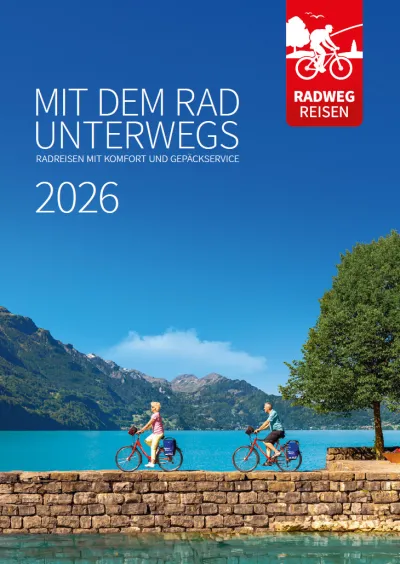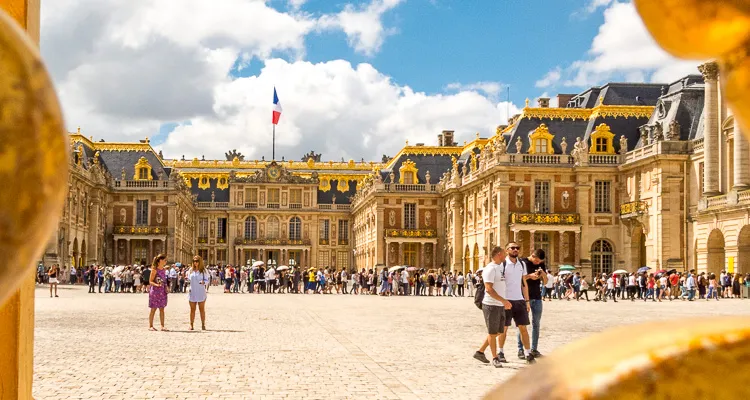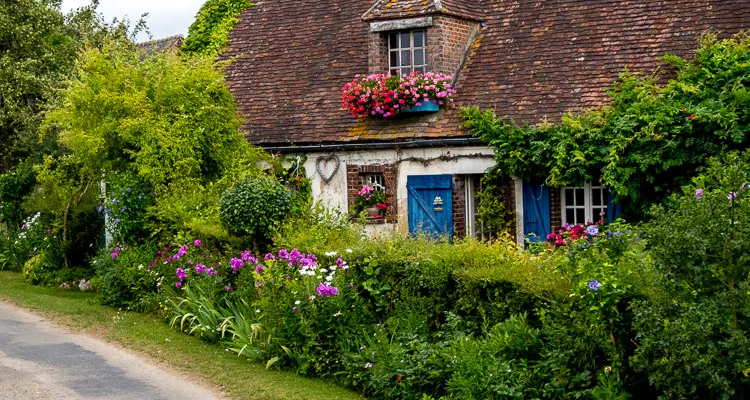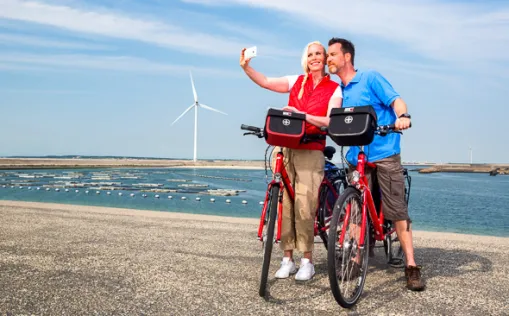

Travel report: From Paris to Mont-Saint-Michel
From Radweg-Reisen employee Judith
Cycling like God in France. Isn't there a saying? Our colleagues Judith and Katharina got to the bottom of it and went on a cycle tour from the capital Paris to Normandy. In this travelogue, they describe what they experienced along the way. Based on their experiences, we have included this trip in our program with a slightly different itinerary.
Show more Show lessSavoir-vivre - my colleague Katharina and I on a tour of France
Paris and Mont-Saint-Michel - magical attractions that have an effect on us! And what lies in between? Vallée de Chevreuse, Vallée Eure-et-Loir, Perche and Normandy-Maine? We look at each other. Rarely heard of. Our curiosity grows. That's where we want to go! A potential cycle tour for our guests from 2018?
Order from our boss: test. We test it. And we're already on the train to Paris.

Paris
In the Montmartre district near our hotel (a renovation of the rooms wouldn't hurt, but the view of the Eiffel Tower can stay!) we breathe in the Parisian air. A quick tour on the day of arrival: the Sacre-Cœur, French cafés and brasseries as well as the typical salons de thé, the many small alleyways. I'm a little sad that we have to leave again tomorrow, but of course I'm also looking forward to tomorrow's first cycling stage to Versailles.

Versailles with palace and water feature
Get on your bike and off you go: Through the heaviest traffic in Paris, time-consuming and nerve-wracking, past Notre-Dame and through the Parisian district of Saint-Germain - and then the lifeline out of the big city: the 15-kilometre-long, asphalted Coulée Verte from Gare de Montparnasse to Massy. A bit of green space and peace and quiet - for pedestrians and cyclists only, at last. We put up with a few road and train track crossings that slowed our pace. Again and again we ask ourselves: Is this the right way? Then finally the first cycle path signs towards Versailles. Suddenly all the tension falls away from me: the Palace of Versailles. Huge and majestic, it lies before us. I find its extensive, meticulously laid out gardens almost more impressive. Various fountains and classical music from loudspeakers take me back to the magnificent times of the Sun King.

Hilly Vallée des Chevreuse with typical French villages
Returning to the cycle path in Versailles is child's play compared to the previous day. The cycle stage through the Vallée des Chevreuse on the Ile de France, on the other hand, proves to be challenging: paved country roads with steeper climbs to the villages have to be mastered. We are rewarded with the pretty stone houses and small, inviting churches typical of this region. A cooling forest section through the forest of Rambouillet in the hot midday sun. The stage drags on. A ten-kilometre detour to the Abbay de Cernay is out of the question for both of us. The Château de Rambouillet with its beautiful park along the route is just right for us to take a breather. Passing the pretty village of Epernon, the route finally leads to Hanches and our accommodation, a typical maison d'hôtes. I feel like a queen of the sun in this rural property with its large, well-kept park and even a swimming pool! This is crowned by a very warm welcome from the hostess and a 4-course menu. It's just as well that there are no other dining options in Hanches.

Castle and gardens of Maintenon - Chartres - Norman air in a suit
Praise to the GPS device that we had taken with us as a precaution and specially loaded with the GPS data that we had found on the Veloscenie long-distance cycle route website. It helped us (and it wouldn't be the last time) from the hotel to the cycle path in the royal valley of the Eure-et-Loir. We searched in vain for cycle path signs there.
Show more Show lessA first eye-catcher is the moated castle of Maintenon, residence of Louis XIV's secret mistress. The royal atmosphere is palpable in the air. The charming gardens reflect the lavish period, while the aqueduct, which was never completed, is a reminder of the project to irrigate the gardens of Versailles at the time. We are both somewhat disappointed by the second highlight of this stage. In the small town of Chartres, the famous Notre-Dame Cathedral may seem more dominant than it actually is. Yes, okay, the famous stained glass windows, the integrity of the cathedral and the High Gothic style make the cathedral something special. We take a look at it and avoid the hot midday sun. From Chartres, we continue on country roads, along main roads, mainly through open fields to Illiers-Combray. The stage drags on. Once again. Motivating: the Perche and Normandy give us a glimpse of their original rural character, which we can experience at first hand over the next few days. The museum dedicated to Marcel Proust in Illiers-Combray, our overnight stop, fits in with my thoughts: A la recherche du temps perdu - In search of lost time with the addition: du Perche - the Norman Perche landscape. I fall asleep satisfied.

The gate of the Perche and Norman en plein air on to Villeray - the most beautiful stage so far
The abbey church with its 12th century monastery garden in Thiron-Gardais: The welcome gate of the Perche. We have to pedal hard again on this stretch, but despite everything, the landscape has a soothing effect on me.
Show more Show lessWe ride along a variety of country roads, through villages with short climbs and somewhat longer descents. Suddenly we come across a privately owned castle and an impressive church tower at the side of the road, followed by a ride through pleasantly cooler sections of forest. The castle of St. Jean in Nogent-le-Rotrou with its medieval fortifications is a welcome break. In the castle, we learn about the history and artists of the Perche. Then the Norman open country opens up before us: the first grazing white cows and meadows adorned with hay bales. And it is windy here. The air becomes noticeably rougher and fresher. It doesn't matter. It makes the longer uphill sections bearable. And downhill too! It rolls. The route is well signposted and mostly asphalted. Now it feels like I've really arrived. A 4* hotel awaits us in Villeray. Very stately. There were no refreshment stops along the way. The excellent 4-course menu tastes all the better. And the French cheese too! A huge selection rolls to our table. Melt in your mouth!

In the sign of the Voie Verte - Normandy-Maine Regional Park with Alençon
The Voie Verte, the French name for official cycle paths (greenway) leads us to Alençon. Around 70 kilometers long. Almost invisible to the eye, but noticeable to the legs: some sections of the Voie Verte are slightly uphill. The gravelly surface with tree roots here and there make cycling difficult. I feel protected by the trees that nestle above me on the right and left. But the animals also feel at home here in the Normandy-Maine Regional Park: a shy weasel, a plodding badger, hopping hares and a deer offer me some variety on the long, mainly straight stretch. I catch glimpses of the pasture landscape with horses, sheep and cows in all colors: white, brown, black and white. Rémalard, known as a small artists' town, can't keep up with the animals. Only Alençon, the city of the dukes with its castle, country estates, Notre-Dame basilica and old town center, is a nice change.

Carrouges Castle and pure Normandy
I didn't know that vigorous and relaxed cycling could go together. In Normandy they do. My legs have got used to the sometimes longer climbs and I'm now mentally prepared. Of course, the descents are also fun. Cycling long distances every day is simply part of this region to experience the landscape, the villages, the stone houses and the castles in their entirety. Take Carrouges Castle, for example, on this stage. One of the largest in Normandy, nestled in moats, the reddish brick is striking and the gardens are striking. The route then continues in familiar fashion on asphalt cycle paths, through pastures and villages with descents and gentle climbs. The cycle path signs almost always guide you reliably. One last up and down through a predominantly asphalted and protected section of forest, the forêt des Andaines. Then we reach Bagnoles de l'Orne, a 19th century spa town with numerous Belle Époque villas. But more importantly: my first galette and a salade de chèvre! Yum!

Domfront and the Voie Verte
The route continues pleasantly through forest on asphalt to Domfront. Very beautiful with an old town center and castle ruins. This is the only place to stop for refreshments or shopping until St. Hilaire. Very motivating: the first signs to Mont-Saint-Michel are already there! The easy ascents and descents allow you to follow the hilly Norman pasture landscape. Faithful companions are: cows, goats and sheep as well as the already familiar Voie Verte - despite the rain this time it is perfectly rideable on asphalt or on firm gravel sand - to Saint Hilaire du Harcouët. The place isn't pretty, but it doesn't matter. Tomorrow is the day: Mont-Saint-Michel is calling!

Only Mont-Saint-Michel to go
The destination is so close and yet so far. How many kilometers are left until then? 38 kilometers? 50 kilometers? The signs are going crazy. After a few kilometers, we leave the Voie Verte. We follow signposted country roads. Once again, it's ups and downs. Then, all of a sudden and hard to believe, it appears far back on the horizon. But the way there is deceptive. You can see Mont-Saint-Michel again and again, but the cycle paths seem to circle around it a thousand times. Sometimes it is closer, then further away again. And then, after a total of 50 kilometers, the time has come. Mont-Saint-Michel looked lonely from afar, but up close we see the opposite: there are people on it, in it and all around it on the mudflats. The black-legged sheep don't seem to mind. They are part of the picture. Compared to the days before, it's the windiest here. And it's getting cloudier and cloudier. The first raindrops fall. We go into the monastery and take a look inside the reception room, the monks' dining room, prayer rooms and several other rooms. Then continuous rain. The weather forecast was right. We put on our rain gear and quickly cycle the 10 kilometers in the rain on a gravel road to Pontorson, our overnight stop. Only the arrival counts. We celebrate Mont-Saint-Michel, the cycle tour and our sporting success with a Kir Breton.

Our conclusion
Sporty on the road:
You should enjoy active cycling and not shy away from long stages of up to 75 kilometers. If you want to see Paris with Notre-Dame, the Palace of Versailles and Mont-Saint-Michel as UNESCO World Heritage Sites at your leisure, you should definitely plan extra nights there. Otherwise you won't have enough time and energy for sightseeing.
Scenic:
The rural character with its regional nature parks such as the Vallée de Chevreuse, the Perche and Normandie-Maine unfolds more and more over the 500 kilometers. Most of the route is on roads with little traffic and from the halfway point, the cycle paths are mostly signposted. Nevertheless, a GPS device is highly recommended, as there are no signs exactly where they would be useful...













